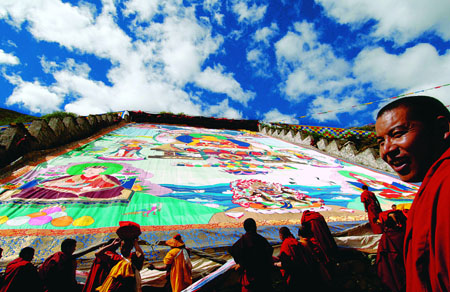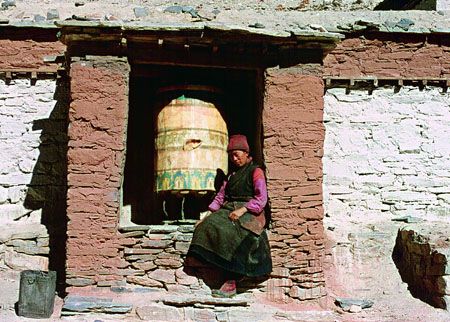| Freedom of religious belief is a basic State policy of China. Article 36 of the Constitution of the People's Republic of China stipulates that all citizens enjoy freedom of religious belief; no State organ, social organization or individual is allowed to force any citizen to believe or not to believe in any religion; nor discriminate against any citizen with or with no religious belief; the State protects normal religious activities.
In old Tibet, all people had to have religious belief and Tibet followed the temporal and religious administration. They enjoyed no freedom to religious belief.

Giant painting of Buddha unfolded for public worship in the Curpu Monastery
In 1959, Tibet underwent Democratic Reform. While abolishing the feudal privileges of the three major feudal lords and upper-class monks, annulling the exploitation system and separating religion from government, due respect was given to the Tibetan people's freedom of religious belief and folk customs. After the Democratic Reform, there are still resident monks and nuns in monasteries and nunneries enjoying a good life, and religious personnel are allowed to conduct their activities freely. All this points up to the fact that the Tibetans enjoy real freedom to religious belief, enjoying the right to be lamas or resume secular life. Various monasteries have elected their own management committees or groups, which handle monastic life. Statistics show there are more than 46,000 monks and nuns in Tibet, or 1.7 percent of the region's population. They are free to recite sutras, pray for good luck and dispelling evils, receive a blessing touch on the forehead from Living Buddha's and can conduct rituals to redeem the sins of the dead. In accordance with the need of the religious activities of the patriotic religious personages and followers, a number of major monasteries have been listed as cultural relics units subject to State or regional protection.
Today, religious followers in Tibet may set up family shrines to worship Buddha at home. They are also free to worship in monasteries. It is a common scene that Tibetan worshippers take ritual walks around holy mountains or holy lakes; devout people hang up sutra streamers, pile up Mani stone mounds, or prostrate themselves along the long way to Buddhist sites. Each year, there are up to a million people worshipping Buddha in the Jokhang Monastery in Lhasa. In addition, religious habits and customs included in wedding or funeral ceremonies are fully respected. Various religious holidays, such as the Grand Summons Ceremony in Lhasa, traditional ritual walk around holy mountains in the Tibetan Year of the Horse, and traditional ritual walk around Nam Co Lake in the Tibetan Year of Sheep, are celebrated as usual.
The Living Buddha reincarnation system, unique to Tibetan Buddhism, still works in Tibet. In 1992, the Central People's Government approved the 17th Living Buddha Garmaba of the Gagyu Sect of Tibetan Buddhism. In 1995, the soul boy of the late 10th Panchen Erdeni was determined through the method of drawing lots from the golden urn in accordance with the set religious rules and with the approval of the Central Government. Living Buddha's thus confirmed work actively in various religious sites.

Tibetan woman after having taken ritual walks |





